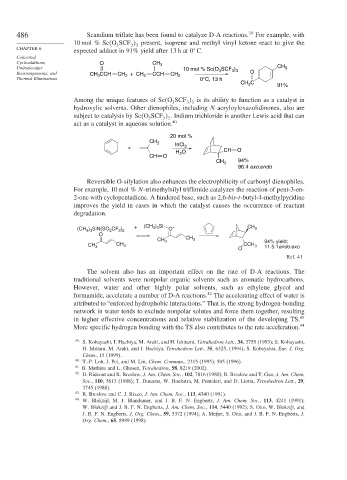Page 512 - Advanced Organic Chemistry Part B - Reactions & Synthesis
P. 512
486 Scandium triflate has been found to catalyze D-A reactions. 39 For example, with
10 mol % Sc O SCF present, isoprene and methyl vinyl ketone react to give the
3
3 3
CHAPTER 6
expected adduct in 91% yield after 13 h at 0 C.
Concerted
Cycloadditions, O CH 3
Unimolecular 10 mol % Sc(O SCF ) CH 3
Rearrangements, and CCH CH + CH CCH CH 3 3 3 O
CH 3 2 2 2
Thermal Eliminations 0°C, 13 h
CH C 91%
3
Among the unique features of Sc O SCF is its ability to function as a catalyst in
3
3 3
hydroxylic solvents. Other dienophiles, including N-acryloyloxazolidinones, also are
subject to catalysis by Sc O SCF . Indium trichloride is another Lewis acid that can
3
3 3
act as a catalyst in aqueous solution. 40
20 mol %
CH 3
+ InCl 3
H O CH O
2
CH O
CH 3 94%
96:4 exo:endo
Reversible O-silylation also enhances the electrophilicity of carbonyl dienophiles.
For example, 10 mol % N-trimethylsilyl triflimide catalyzes the reaction of pent-3-en-
2-one with cyclopentadiene. A hindered base, such as 2,6-bis-t-butyl-4-methylpyridine
improves the yield in cases in which the catalyst causes the occurrence of reactant
degradation.
+ (CH 3 ) 3 Si + CH 3
(CH 3 ) 3 SiN(SO 2 CF 3 ) 2 O
O
CH 3
CH 3 94% yield;
CH 3 CCH 3
CH 3 11.5:1endo:exo
O
Ref. 41
The solvent also has an important effect on the rate of D-A reactions. The
traditional solvents were nonpolar organic solvents such as aromatic hydrocarbons.
However, water and other highly polar solvents, such as ethylene glycol and
42
formamide, accelerate a number of D-A reactions. The accelerating effect of water is
attributed to “enforced hydrophobic interactions.” That is, the strong hydrogen-bonding
network in water tends to exclude nonpolar solutes and force them together, resulting
in higher effective concentrations and relative stabilization of the developing TS. 43
More specific hydrogen bonding with the TS also contributes to the rate acceleration. 44
39 S. Kobayashi, I. Hachiya, M. Araki, and H. Ishitami, Tetrahedron Lett., 34, 3755 (1993); S. Kobayashi,
H. Ishitani, M. Araki, and I. Hachiya, Tetrahedron Lett., 35, 6325, (1994); S. Kobayahsi, Eur. J. Org.
Chem., 15 (1999).
40
T.-P. Loh, J. Pei, and M. Lin, Chem. Commun., 2315 (1995); 505 (1996).
41 B. Mathieu and L. Ghosez, Tetrahedron, 58, 8219 (2002).
42
D. Rideout and R. Breslow, J. Am. Chem. Soc., 102, 7816 (1980); R. Breslow and T. Guo, J. Am. Chem.
Soc., 110, 5613 (1988); T. Dunams, W. Hoekstra, M. Pentaleri, and D. Liotta, Tetrahedron Lett., 29,
3745 (1988).
43 R. Breslow and C. J. Rizzo, J. Am. Chem. Soc., 113, 4340 (1991).
44
W. Blokzijl, M. J. Blandamer, and J. B. F. N. Engberts, J. Am. Chem. Soc., 113, 4241 (1991);
W. Blokzijl and J. B. F. N. Engberts, J. Am. Chem. Soc., 114, 5440 (1992); S. Otto, W. Blokzijl, and
J. B. F. N. Engberts, J. Org. Chem., 59, 5372 (1994); A. Meijer, S. Otto, and J. B. F. N. Engberts, J.
Org. Chem., 65, 8989 (1998).

